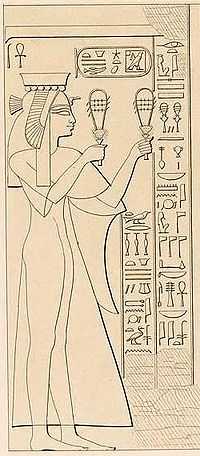Duathathor-Henuttawy
- For other Egyptian ladies called Henuttawy see Henuttawy
| ||||
| Duathathor-Henuttawy in hieroglyphs |
|---|

Duathathor-Henuttawy or Henuttawy (“Adorer of Hathor; Mistress of the Two Lands”) was an ancient Egyptian princess and later queen. She is likely to have been the daughter of Ramesses XI, last king of the 20th dynasty[1] by Tentamun.[2] She married Pinedjem I, the Theban High Priest of Amun who was de facto ruler of Upper Egypt and took on pharaonic titles later on. Henuttawy's sister Tentamun married Pharaoh Smendes I, who was pharaoh of Egypt, but in reality ruled only Lower Egypt from Tanis.
Duathathor-Henuttawy held several titles, including King's Daughter; King's Wife; King's Mother; Lady of the Two Lands; Mistress of the Two Lands; Daughter of the Great Royal Wife; Foremost Singer of Amun; Mother of the Great Royal Wife; Mother of the High Priest of Amun; Mother of Generalissimo.[1] This helps us identify which of Pinedjem's children were hers: Psusennes I, who went on to become pharaoh in Tanis; his wife Mutnedjmet; and Maatkare, who became God's Wife of Amun. It is likely she was also the mother of Henuttawy who is depicted along with Maatkare and Mutnedjmet in Karnak.[3] It is more difficult to identify the high priest referred to in her titles: three of Pinedjem's sons, Masaharta, Djedkhonsuefankh and Menkheperre became high priests, and one, two, or all three of them could have been Duathathor-Henuttawy's son.[4]
She is mentioned before her husband's ascendence to the throne on a chalice found in Tanis, on a door lintel and on a relief in the Khonsu temple in the Karnak temple complex. Even here she is mentioned as a queen, with her name written in a cartouche. Later she is also mentioned on a stela in Coptos, in Mut's temple in Karnak and on several objects found in her son's tomb in Tanis. She is depicted on the facade of the Khonsu temple in Karnak.[5]
Her mummy and coffins were found in the DB320 cache along with those of several members of her immediate family. They are now in the Egyptian Museum of Cairo.[1]

![N14 [dwA] dwA](/2014-wikipedia_en_all_02_2014/I/media/h/i/e/r/hiero_N14.png)

![X1 [t] t](/2014-wikipedia_en_all_02_2014/I/media/h/i/e/r/hiero_X1.png)

